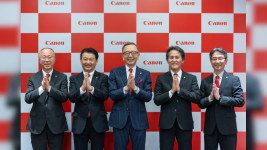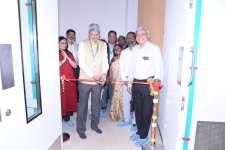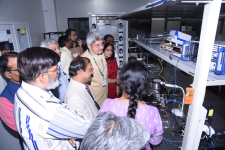Canon eyes chip fabrication in India, in talks for lithography machine
Press Trust of India, New Delhi
Last Updated: Dec 22, 2024
1:21 PM IST
Besides its core business of imaging, printing, and surveillance, Canon India is also trying to make its presence in fields like semiconductors, flat panel display business, and the medical industry.
 Nomura said Canon has a vision to replicate that success in the Indian market and contribute to society and healthcare here. | File Image
Nomura said Canon has a vision to replicate that success in the Indian market and contribute to society and healthcare here. | File Image
Japanese imaging and optical products major Canon believes that it has a good opportunity in India for its semiconductor lithography equipment required for chip fabrication, and it is in negotiations with companies setting up facilities here, said its India President and CEO Toshiaki Nomura.
Though Canon did not disclose names, it said there are immense opportunities in this, as many chip manufacturers are now eying India as a new destination for semiconductor manufacturing.
"A lot of chip manufacturers are eyeing India as a new manufacturing place. We are discussing with all those chip manufacturers to give our product and service," Nomura told PTI.
This is a "good opportunity for us", and the Tokyo-based group can contribute through its technology, products and services in this segment of the Indian market, he added.
"We are installing the equipment for them to manufacture chips through our technology and the product. We help chip manufacturers build a strong facility in India. Once the chip manufacturer sets up the facility in India, we will install our equipment and through our excellent product and the support we can contribute to Indian semiconductor industries," Nomura added.

"We are now at the negotiation stage. I cannot disclose this information now, but we have our ground discussion ongoing." For Canon, India is "one of the most important markets" globally, where the company is growing with double digits and expects to continue that pace of growth here supported by tailwinds, such as a growing economy, rapid urbanisation, and young demography, among others.
"In 2024, we are quite close to double-digit growth, and for coming years, I am very optimistic and confident to achieve double-digit growth year by year," Nomura said, adding that "all business portfolios for us are showing the growth".
Besides its core business of imaging, printing, and surveillance, Canon India is also trying to make its presence in fields like semiconductors, flat panel display business, and the medical industry, where it offers a range of diagnostic medical imaging solutions, including CT, MR, X-ray, Ultrasound, and Healthcare Informatics.
"The potential of the growth of healthcare business is huge. We want to tap those," he said, adding that "our presence is small, but in Japan, we are one of the biggest manufacturer brands for the diagnostic product range, such as CT scans, MRI, ultrasounds and X-rays".
Nomura said Canon has a vision to replicate that success in the Indian market and contribute to society and healthcare here.
Besides, Canon is also encouraged by responses to its 'NorthStar' initiative, which is a one-stop solution platform for providing advisory, equipment, and associated services to help customers set up studio operations.
"The response is very positive," Nomura said, adding that under the initiative, it is providing complete solutions to studio owners, helping them make their production work more efficient.
"We invite trusted technology partners to give advice and end-to-end consultation not only for the imaging camera but also for the audiovisuals," he noted.
People have appreciated it, and Canon has already closed several projects, and now several are at the ongoing stage, he added.
Canon India expects a similar double-digit growth coming from its consumer-facing B2C and institutional segment B2B.
"India's market potential is immense from many aspects. GDP growth is the fastest among all the big countries. Also, young age and the work population are growing with urbanisation, and tier II and III cities have a faster pace of growth with infrastructure setup. All those are the positive factors for us to grow, together with India's economic growth," Nomura said.
Besides the metro market, Canon is now trying to tap these fast-growing smaller tiers II and III cities using its partners in its different business verticals.
"Canon group considers India as one of the most important markets, and to penetrate the market, we have a strategy that geographically, we go into the tier II, III cities to tap these fast growth markets. That is one of the strategies, and by using our partners' network, we can penetrate those booming, emerging cities," he said.
It will also focus on some industries like IT, pharma, BFSI, and government services and increase its penetration.
While its traditional DSLR cameras, it sees further growth in coming years led by booming wedding photography, wildlife, fashion and OTT content creators. It is also enhancing its play into the mirrorless camera, where it is facing stiff competition from other rival Japanese companies like Sony and Fuji in the Indian market.
Canon India's revenue from Sales and Services was Rs 3,148.13 crore with a net profit of Rs 140.35 crore in FY 2022-23, according to the data sourced from the business intelligence platform Tofler.
Canon India is a 100 per cent sales and marketing subsidiary of Canon Inc Japan.
(Only the headline and picture of this report may have been reworked by the Business Standard staff; the rest of the content is auto generated from a syndicated feed.)
https://www.business-standard.com/c...s-for-lithography-machine-124122200181_1.html















